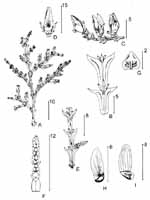 "Papuacedrus papuana (F. Mueller) Li. A-B. part of branchlet, C. part of branchlet with fruit, D. fruit, E. part of branchlet with male cone, F. male cone, G. microsporophyll, H-I. seeds." (2). | Papuacedrus papuana (F. Mueller) LiCommon Names"Ab (Nega, Kepilam), aiap (Enga), araoem (Karoon), autibo (Kepauko), bit (Yogom), boetsga (Manikiong), bootsjeka (Manikiong), dautie (Kepauko), doewak (Kebar), dzagosa (Asaro, Kefamo), dzasihanini (Asaro, Kefamo), eis (Karoon), gamgan (Hagen, Togoba), gamuga (Hagen, Togoba), hohoba (Lei area), hap (Enga, Kepilam), iwunturra (Manki), juta (Mairi, Watabung), kaibelkombam (Wahgi, Minji), kaipil (Wahgi, Ninj), kamgenkuna (Hagen, Togoba), kap (Enga, Kepilam), matoe (Kepauko), mondalasap (Mendi), mondilasop (Mendi), nipaoe (Kebar), ogeleh (Chimbu, Masul), oleh (Chimbu, Masul), ongol (Wahgi, Minj), pomoan (Manikiong), sowa (Kebar, Andjai), sukou (Wapi, Migote), swa (Andjai), tera (Garaina), toewa (Kebar), urenak (Mendi), wonga (Arfak), ye-enka (Nauti)" (2).Taxonomic notesSyn: Libocedrus papuana F. Mueller 1889; Thuja papuana Voss 1908; P. torricellensis (Schlechter) Li 1953; Librocedrus torricellensis Schlechter 1913; P. arfakensis (Gibbs) Li 1953; Libocedrus arfakensis Gibbs 1917. Holotype from Owen Stanley Range (2). The sole species in Papuacedrus Li 1953 (syn: Libocedrus Endl. 1847; Austrocedrus Florin & Boutelje 1954) (2).Van Royen (2) regards Papuacedrus as a monotypic genus, and that classification is here used. Li (3) segregated two additional species (listed in synonymy above). Van Royen argues that the observed variations are due to phenotypic plasticity that is expected in a taxon with such a wide range of habitats. Description"Trees, 16-50 m tall, rarely shrubs of 1-3 m, entirely glabrous, with open crown and horizontally spreading, or when older slightly pendulous at tip of branches; bole (2-)14-37 m, d.b.h. (10-)40-60 cm; with distinct resinous smell. Outer bark black, blackish grey, greyish brown, or brown, longitudinally grooved, slightly or not peeling, sometimes deeply grooved and strongly peeling with small scales or long fibres. Inner bark pinkish brown, or straw-coloured, becoming white towards centre, with some yellowish resin. Sapwood light brown, yellow or white. Heartwood purple brown, reddish brown, brown, or light brown. Branchlets slender, compressed, glabrous. Leaves light green, or dark olive above and greener below, sometimes greyish silvery, or glaucous on underside; in fertile branches leaves much smaller than in sterile branches; lateral leaves obliquely oblong, sigmoid-oblong, falcate, ovate, or lanceolate, often convex above and concave below, 1-nerved and the nerve often crested above, but sometimes grooved above, always prominent below, sometimes with 1 branched lateral nerve on either side, outer margin sigmoid or curved, inner margin straight; median leaves squamiform, rhombate, rhombate-ovate, rhombate-lanceolate, triangular, or broadly ovate, 0.5-4 mm long, acute, acuminate or caudate, 1- or 2-crested. Male branchlets 6-12 mm long, with 8-30 microsporophylls in a cylindric, 4-25 by 2-3 mm large strobilus, each microsporophyll shield-like, peltate, 1-1.5 mm across, acute, obtuse, or rounded, stalk 0.5-1 mm long. Pollen sacs 0.5-1 mm across. Female branchlets 2-10 mm long with a few leaves below cone, outer scales of cone oblong to ovate, or ovate-elliptic, 4-7 by 2-5 mm, acute or shortly acuminate, at base connate to an oblong, shield-like or ovate, 1-2.5 by 0.5-2 mm large bract, which is acute or obtuse at tip, tip curving outwards and often hook-tipped on inside, inner scales of cone lanceolate, broadly elliptic, sometimes elliptic-ovate, 6-12 by 2-5 mm, obtuse or acute, on outside up to the middle connate with a triangular or ovate bract, tip of latter obtuse or acute, curving outwards; all scales at first yellowish green, often glaucous, but in the ripe fruit becoming brown, blackish brown or black, often with ridges radiating from tip of bracts either on both sides or on outside only. Seeds elliptic, often oblique, 1.5-2.5 by 1-2 mm, with a broadly oblong, often oblique, 4-6 by 2-3 mm large, rounded or obtuse wing with many either radiating or parallel nerves" (2).RangeNew Guinea and eastern Moluccas. Regional distribution in New Guinea is as follows:W New Guinea: "Aifat Valley, Tobi Mts, Kebar Valley, Mt Nettoti, Arfak Mts, Mt Genofa, Wissel Lakes area, Mt Doorman, Ilaga, Otomona Valley, Mt Goliath, Hellwig Mts, Mt Agathodaemonis, Idenburg River area, Lake Habbema area, Mt Wihelmina area, Star Mts, Cycloop Mts. "TNG. Torricelli Mts, Star Mts, Hindeberg Range, Victor Emanuel Mts, McNicoll-Andabare Plateau, Ambum Valley, Wabag, Mt Hagen area, Kerowagi area, Wahgi-Jimmy Divide, Kubor Range, Nondugl area, Mt Wilhelm area, Mt Otto, Daulo, Finisterre Mts, Sarawaket Mts, Cromwell Mts, Mt Amungwiwa, Watut Valley, Bulolo-Wau area. Papua: "Kaugel Valley, Mt Ambua, Mt Kerewa, Mt Giluwe, Mt Jalibu, Mt Dickson, Owen Stanley Range, Mt Knutsford, Wharton Range, Mt Albert Edward, Mt Victoria, Milne Bay district, Mt Maneau, Mt Dayman. "A widespread, variable species from the upper lowland forests to the subalpine shrubberies where it is often noticeable as one of the few trees emergent over the shrubberies, 800-3800 m. Flowers the whole year round with probably a main flowering period between March and September, much depending on the altitude and local position" (2). Big TreeOldestDendrochronologyEthnobotany"The timber is rather extensively used for building purposes, while the bark is used for roofing" (2).ObservationsRemarksCitations(1) Silba 1986.(2) van Royen 1979 (3) Li Hui-Lin. 1953. Journal of the Arnold Arboretum 34:25. |
[Papuacedrus] [Cupressaceae] [home] This page is from the Gymnosperm Database |